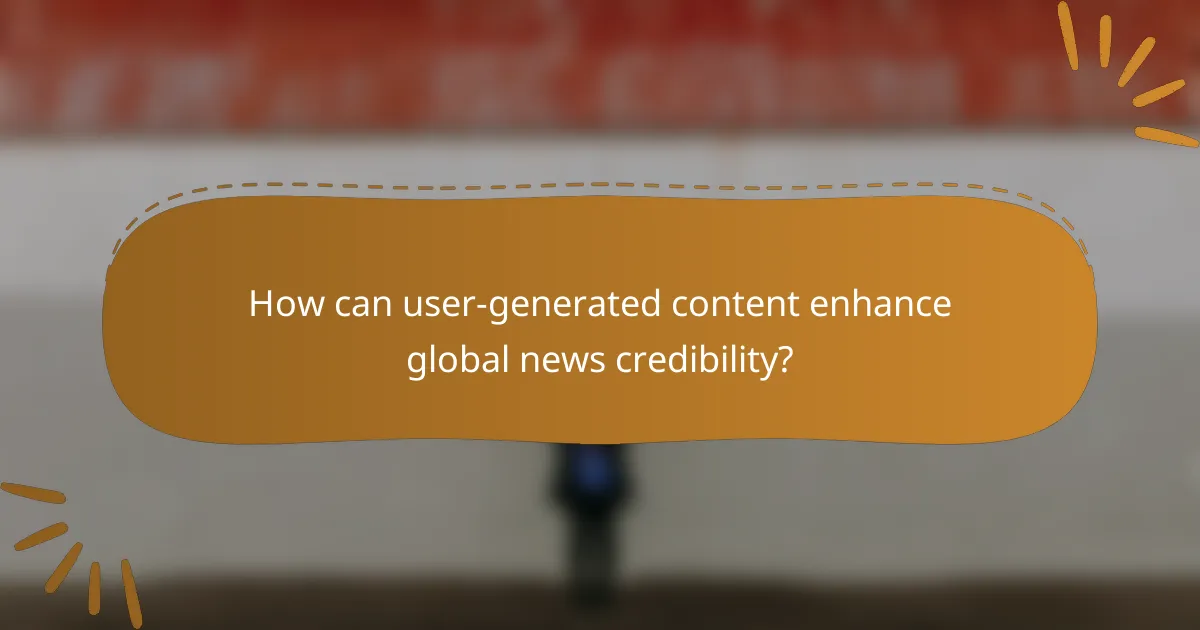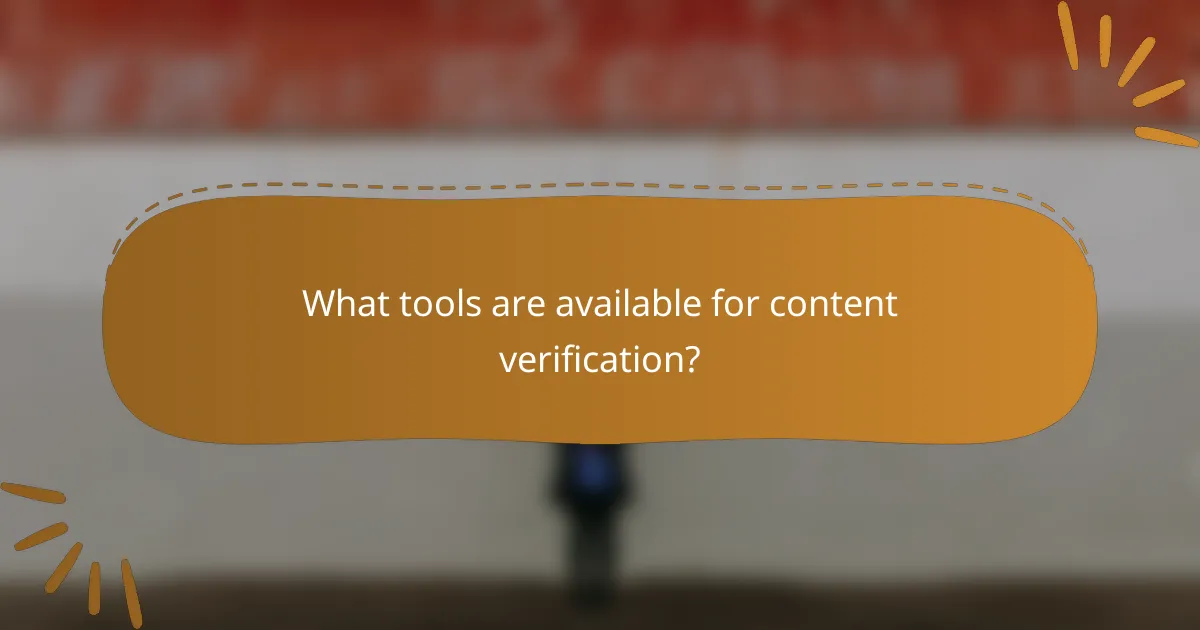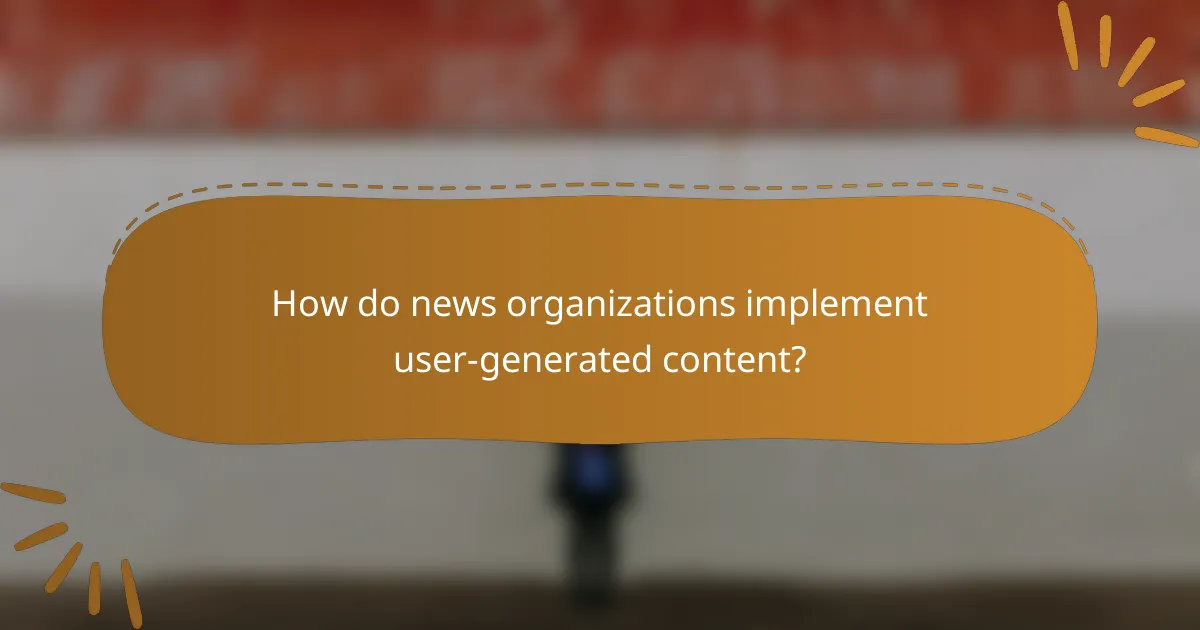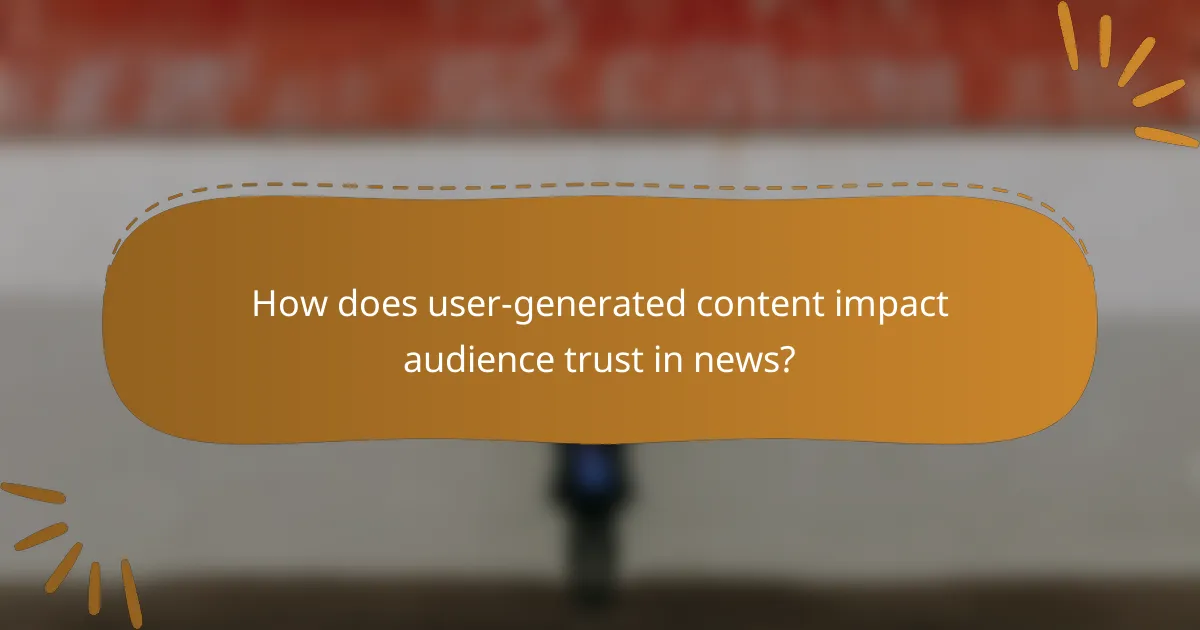User-generated content plays a crucial role in enhancing the credibility of global news by offering firsthand accounts and a variety of perspectives. To maintain trust, news organizations must prioritize the verification of this content through best practices such as cross-referencing sources and engaging with original creators. Utilizing specialized tools for fact-checking further ensures the accuracy and reliability of the information presented.

How can user-generated content enhance global news credibility?
User-generated content can significantly enhance the credibility of global news by providing firsthand accounts and diverse viewpoints. This type of content allows news organizations to verify information through multiple sources, fostering trust among audiences.
Increased audience engagement
User-generated content fosters greater audience engagement by encouraging individuals to participate in the news-gathering process. When people share their experiences or insights, they feel a sense of ownership and connection to the news, which can lead to higher levels of interaction and discussion.
News platforms can enhance engagement by creating dedicated sections for user submissions, allowing readers to contribute photos, videos, or articles. This not only enriches the content but also builds a community around shared interests and experiences.
Diverse perspectives
User-generated content brings a variety of perspectives to global news, reflecting the experiences of different cultures and communities. This diversity helps to paint a fuller picture of events, moving beyond traditional narratives and biases that may exist in mainstream media.
For example, during a significant global event, local voices can provide context and insights that national outlets might overlook. This can lead to more balanced reporting and a deeper understanding of complex issues.
Real-time updates
User-generated content allows for real-time updates during breaking news situations. Individuals on the ground can share information instantly, which can be crucial for timely reporting and situational awareness.
News organizations can leverage platforms like social media to gather real-time updates from users, ensuring that they remain informed about ongoing developments. However, it is essential to verify this information before publishing to maintain credibility and avoid spreading misinformation.

What are the best practices for verifying user-generated content?
Verifying user-generated content (UGC) is essential to ensure its credibility and reliability. Best practices include cross-referencing sources, utilizing fact-checking tools, and engaging directly with the original content creators.
Cross-referencing sources
Cross-referencing involves checking the information against multiple credible sources to confirm its accuracy. This practice helps identify discrepancies and provides a broader context for the content. For instance, if a user claims an event occurred, verifying it through news articles, official statements, or social media posts from reputable accounts can enhance reliability.
When cross-referencing, prioritize sources that are known for their journalistic integrity. Look for established news organizations or official government websites, as these are often more trustworthy than personal blogs or unverified social media accounts.
Using fact-checking tools
Fact-checking tools are designed to assess the validity of claims made in user-generated content. Websites like Snopes, FactCheck.org, or PolitiFact can be instrumental in verifying statements or statistics. These platforms often provide detailed analyses and sources, making them valuable resources for anyone evaluating UGC.
In addition to online tools, consider browser extensions that flag potentially misleading information. These can serve as a first line of defense against false claims while browsing social media or news sites.
Engaging with original content creators
Directly engaging with the original creators of user-generated content can provide insights into their intentions and the context behind their posts. This interaction can clarify any ambiguities and help assess the credibility of the information presented. Asking questions or requesting additional evidence can lead to a more informed evaluation.
When reaching out, maintain a respectful tone and be clear about your purpose. This approach not only fosters better communication but may also encourage creators to provide more accurate and detailed information in the future.

What tools are available for content verification?
Several tools can help verify user-generated content, ensuring its credibility and accuracy. These tools utilize various methods, including fact-checking databases and community-driven platforms, to assess the reliability of information.
Google Fact Check Explorer
Google Fact Check Explorer is a powerful tool that allows users to search for fact-checked claims across various topics. It aggregates information from reputable sources, displaying whether claims are true, false, or misleading.
To use it, simply enter a statement or topic in the search bar. The results will show fact-checks from multiple organizations, providing context and sources for each claim. This can help users quickly assess the validity of information they encounter online.
ClaimReview
ClaimReview is a structured data markup that allows fact-checkers to annotate claims made in articles and social media posts. This tool helps search engines display fact-checking information directly in search results, enhancing transparency.
When using ClaimReview, content creators can tag their articles with specific claims and the corresponding fact-checking results. This helps users identify credible sources and understand the context of the claims being made.
Snopes
Snopes is one of the most well-known fact-checking websites, focusing on debunking rumors, myths, and misinformation. It covers a wide range of topics, from urban legends to current events, providing detailed analyses of claims.
Users can search for specific claims or browse categories to find relevant information. Snopes often includes sources and references, allowing users to verify the credibility of the information presented. It is a valuable resource for anyone looking to discern fact from fiction online.

How do news organizations implement user-generated content?
News organizations implement user-generated content (UGC) by integrating contributions from the public into their reporting processes. This approach enhances engagement and provides diverse perspectives, but it requires careful management to ensure credibility and accuracy.
Incorporating social media feeds
Many news organizations incorporate social media feeds to showcase real-time updates and reactions from the public. By curating posts from platforms like Twitter and Instagram, they can highlight trending topics and community sentiments. This practice not only enriches content but also fosters a sense of immediacy and relevance.
However, it is crucial to verify the authenticity of the posts shared. News outlets often employ tools and teams to fact-check information before it is published, ensuring that only credible sources are featured.
Hosting community forums
Community forums allow news organizations to create spaces where users can discuss topics and share their insights. These platforms encourage dialogue and can lead to the discovery of unique stories that may not be covered otherwise. Forums can be moderated to maintain a respectful environment and to filter out misinformation.
To maximize participation, organizations should promote these forums through their main channels and consider incentivizing contributions with recognition or rewards. Clear guidelines on acceptable content can help maintain quality and relevance.
Encouraging citizen journalism
Encouraging citizen journalism empowers individuals to report on local events and issues, often filling gaps left by traditional media. News organizations can provide training and resources to help citizens understand ethical reporting standards and effective storytelling techniques. This collaboration can lead to richer, more localized coverage.
Organizations should establish clear submission guidelines and offer feedback to citizen journalists to enhance their skills. Additionally, featuring citizen-generated content prominently can motivate others to participate and contribute their perspectives.

What challenges do news organizations face with user-generated content?
News organizations encounter several challenges with user-generated content, primarily around verifying authenticity and maintaining credibility. As the volume of content increases, so does the risk of misinformation and varying quality, which can undermine trust in news outlets.
Managing misinformation
One of the biggest challenges is managing misinformation that can spread rapidly through user-generated content. News organizations must implement robust verification processes to distinguish between credible sources and false information. This often involves cross-referencing claims with established facts and utilizing fact-checking tools.
Additionally, organizations should educate their audience on recognizing misinformation, encouraging critical thinking and skepticism towards unverified content. Simple guidelines, such as checking the source’s credibility and looking for corroborating reports, can empower users to discern the truth.
Ensuring content quality
Ensuring the quality of user-generated content is crucial for maintaining journalistic standards. News organizations should establish clear guidelines for submissions, outlining what constitutes acceptable content. This may include criteria such as relevance, accuracy, and adherence to ethical standards.
Moreover, employing a moderation team can help review submissions before publication. This team can assess the content’s quality and relevance, ensuring that only high-quality contributions are shared with the audience.
Legal implications
Legal implications arise when news organizations publish user-generated content, particularly concerning copyright and defamation. Organizations must be aware of copyright laws to avoid infringing on the rights of content creators. Obtaining permission or providing proper attribution is essential when using others’ work.
Furthermore, organizations should have policies in place to address potential defamation claims that may arise from user submissions. This includes understanding the legal protections available under laws such as the Communications Decency Act in the United States, which can shield platforms from liability for user-generated content, provided they do not engage in editorial control.

How does user-generated content impact audience trust in news?
User-generated content (UGC) can significantly enhance audience trust in news by providing diverse perspectives and fostering community engagement. However, the credibility of this content often hinges on verification processes and the reputation of the platforms that host it.
Building community trust
Community trust is built when news organizations actively engage with their audience and incorporate user-generated content. This interaction can create a sense of belonging and shared ownership among community members, leading to increased trust in the news being reported.
To effectively build trust, news outlets should establish clear guidelines for content submission and verification. For example, encouraging users to provide context or sources for their contributions can enhance credibility. Transparency about how UGC is used in reporting also plays a crucial role.
Additionally, recognizing and highlighting valuable contributions from users can strengthen community ties. This could involve featuring user stories or insights in articles, which not only validates the contributors but also enriches the overall news narrative.
